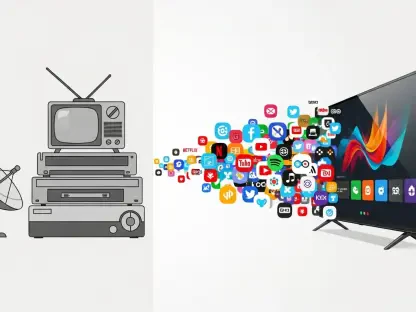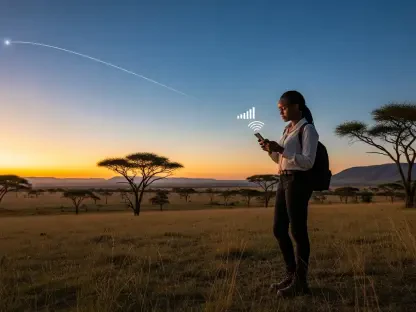Imagine a world where language barriers no longer hinder international business deals, where a sales executive in New York can seamlessly negotiate with a supplier in Shanghai without needing an interpreter, and where technology bridges the gap effortlessly. This vision is inching closer to reality with the advent of cutting-edge technology embedded in everyday devices. Apple’s Live Translation feature, integrated into select AirPods models, is poised to revolutionize global communication by offering real-time language translation directly through earbuds. Paired with advanced iPhone models, this innovation allows users to hear translations instantly while facilitating dialogue with others through displayed or vocalized responses. As businesses increasingly operate across borders, the potential for such a tool to streamline interactions and foster collaboration is immense. This article explores how this technology could reshape enterprise environments, delving into its current capabilities, practical applications, and the future possibilities it holds for breaking down linguistic divides in professional settings.
Breaking Down Language Barriers with Real-Time Tech
The core strength of the Live Translation feature in AirPods lies in its ability to facilitate effortless communication across languages in real time. Available on models like AirPods 4, AirPods Pro 2, and AirPods Pro 3 when connected to compatible iPhone devices, this technology enables users to hear translated speech directly in their earbuds while the other party receives responses via the phone. Though currently limited by language support and regional availability, the feature represents a significant leap toward natural, unhindered dialogue. For global businesses, this means the potential to reduce reliance on third-party translation services for routine interactions, saving time and resources. The seamlessness of hearing a foreign language translated instantly into one’s native tongue could transform how multinational teams operate, making cross-border communication as simple as a local conversation. While not yet perfect, the groundwork laid by this innovation hints at a future where language differences become a minor inconvenience rather than a major obstacle.
Beyond the technical marvel, the psychological impact of such technology on business relationships cannot be understated. Miscommunication due to language barriers often leads to mistrust or missed opportunities in international dealings. With Live Translation, the clarity and immediacy of exchanges could build stronger rapport between parties who previously struggled to connect. Picture a scenario where a project manager in London coordinates with developers in Seoul during a critical product launch, each understanding the other’s intent without delay or distortion. This level of directness fosters confidence and efficiency, key drivers in competitive markets. Additionally, the technology’s integration into a widely used device like AirPods means adoption could be swift among professionals already familiar with the ecosystem. As refinements continue, addressing current gaps in language coverage and usability, the potential for this tool to become a staple in global business communication grows exponentially, paving the way for more inclusive and dynamic interactions.
Practical Applications in Diverse Business Scenarios
One of the most compelling aspects of Live Translation through AirPods is its versatility across various business contexts. Imagine attending an international conference in Tokyo, where participants from multiple countries engage in discussions without needing human interpreters for casual exchanges. This technology allows attendees to follow presentations and converse with peers in real time, hearing translations directly while responding through their device. Similarly, for business travelers navigating customer interactions in regions with unfamiliar languages, such as negotiating with vendors in a French-speaking market, the feature offers a practical solution to communicate effectively on the spot. Multinational corporations could see significant benefits in streamlining operations across time zones, as teams collaborate without the friction of linguistic misunderstandings. While not yet a replacement for specialized translation in high-stakes fields like law or medicine, its utility in everyday professional exchanges is undeniable and transformative.
Another critical area where this technology shines is in enhancing customer-facing roles within global industries. Sectors like tourism, retail, and hospitality often deal with diverse clientele, where language differences can impede service quality. With Live Translation, staff equipped with AirPods could assist international customers seamlessly, whether guiding a tourist through a city or resolving a query in a store. This capability not only improves customer satisfaction but also positions companies as innovative and accessible in competitive markets. Furthermore, the technology could influence global sports management, where coaches, players, and organizers from varied backgrounds coordinate events or training sessions without linguistic hurdles. The ability to foster clear communication in such dynamic environments underscores the broader impact on operational efficiency. As language support expands and user experience improves, the scope of these applications will likely widen, embedding real-time translation into the fabric of international business interactions.
Future Prospects and Challenges to Overcome
Looking ahead, the trajectory of Live Translation suggests a profound shift in how global business communication evolves over the coming years. If current limitations such as battery life, comfort for prolonged wear, and incomplete language coverage are addressed, this feature could become an invisible yet indispensable part of professional life. Envision a scenario a few years from now, where executives no longer need to prioritize language learning for business purposes, as real-time translation handles most interactions with ease. Apple’s ongoing advancements in device design and artificial intelligence capabilities fuel optimism that these enhancements are within reach. The potential for this technology to minimize the role of interpreters in routine settings could redefine resource allocation in enterprises, redirecting focus toward innovation and growth. While not expected to fully replace human expertise in nuanced contexts soon, its role in simplifying day-to-day exchanges signals a transformative trend in global collaboration.
However, the path forward is not without hurdles that must be navigated to realize this vision. Present constraints, including regional restrictions and the need for specific hardware compatibility, limit accessibility for some businesses. Additionally, ensuring accuracy in translations across diverse dialects and cultural nuances remains a challenge, as misinterpretations could still disrupt critical communications. Battery performance and ergonomic design also require attention to support all-day use in demanding professional environments. Despite these obstacles, the commitment to refining such technology offers hope for broader implementation. Overcoming these issues will likely involve iterative updates and user feedback, ensuring the feature adapts to real-world needs. As solutions emerge, the integration of real-time translation into everyday business tools could fundamentally alter how companies approach international partnerships, making language barriers a diminishing concern in an increasingly connected world.
Shaping a Borderless Business Landscape
Reflecting on the journey of Live Translation with AirPods, it becomes evident that even in its early stages, this technology lays a foundation for monumental change in global business communication. Its initial rollout showcases the power to bridge linguistic divides in real time, offering a glimpse into a future where seamless interaction across cultures is not just possible but commonplace. The practical benefits witnessed in meetings, travel, and customer service scenarios highlight its immediate value, while ongoing improvements promise even greater impact. Looking back, the focus on overcoming early limitations like language coverage and device constraints proves crucial in shaping its adoption. For businesses that embrace this innovation, the next steps involve integrating it into workflows, training teams to leverage its capabilities, and advocating for expanded accessibility. As refinements continue, the vision of a borderless professional landscape grows clearer, urging companies to prepare for a world where communication knows no linguistic bounds, fostering deeper connections and unprecedented opportunities.









